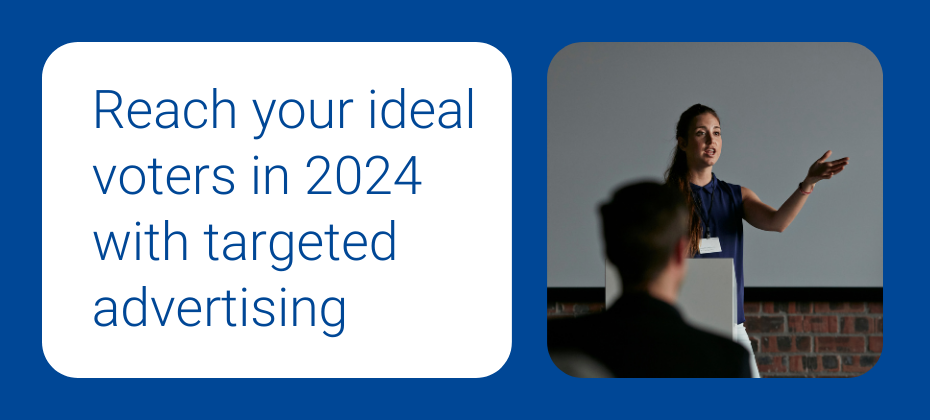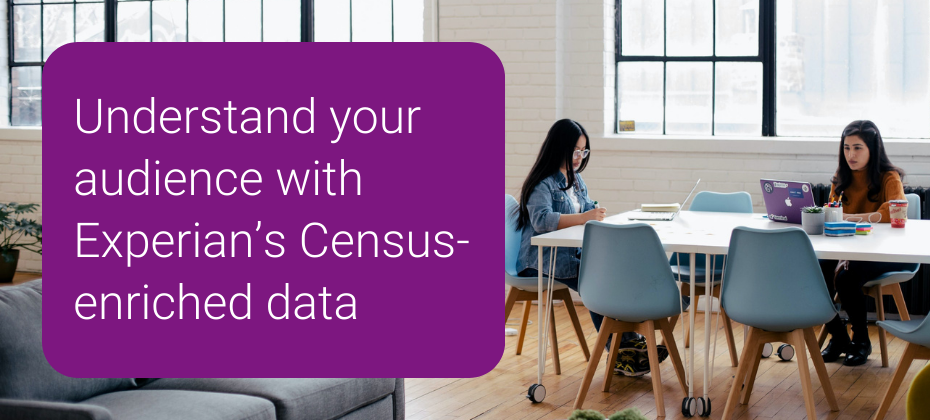Understand your customer
The latest insights in customer preferences, needs and behaviors, and tips for turning that insight into actionable marketing decisions.

Explore the impact of cookie deprecation on digital marketing and learn strategies to adapt using ethical data practices and first-party data.

In the post-cookie landscape, staying ahead requires innovative strategies and partnerships. This case study dives into how MiQ, a leader in the cookieless era, strengthened its Identity Spine with the integration of Experian's cross-device Graph. Challenge MiQ faced a pivotal challenge in avoiding a static approach to strategies and partners while evolving its cookieless initiatives. MiQ aimed to build omnichannel interoperability by integrating privacy-first partners into its Identity Spine. MiQ's primary objectives included: Reaching target audiences in privacy-compliant ways. Expanding their cookieless targeting solutions. Maintaining or increasing the scale expected from cookie-based targeting. Solution To address these challenges, MiQ strategically incorporated Experian's cross-device Graph into its proprietary Identity Spine. MiQ's Identity Spine seamlessly connects over 60 cookieless data feeds and 25 ID solutions. The integration allowed MiQ to: Create a unified view: MiQ now has a unified view of its clients' target audiences, enhancing its understanding and targeting capabilities. Increase scale: By matching first-party data to multiple universal IDs, MiQ expanded its reach across devices, contributing to a 51% increase in seed audience reach and a 64% increase in universal IDs. Improve efficiency: The combination of Experian's data with MiQ's Identity Spine facilitated cross-device ID resolution, leading to more accurate measurement and reporting. Experian's global data coverage complemented MiQ's regional expertise, amplifying global reach and adaptability to changing regulations. "Experian's Graph has bolstered our already comprehensive, multi-ID Identity Spine with incredible data on cross-device ownership and cross-channel behavior."Georgie Haig, Strategy and Partnerships Director, MiQ Digital Results The integration of Experian's data solution significantly contributed to the success of MiQ's Identity Spine expansion. The results speak volumes: A 51% increase in seed audience reach across devices. A 64% boost in reaching audiences through universal IDs. Experian's Graph added 6.5 devices to each matched IP address, enhancing scale and targeting capabilities. A 70% match rate in associating MiQ-provided IP addresses with universal IDs. These outcomes showcase how Experian's Graph empowered MiQ to find, grow, and measure customers across screens, providing a future-proofed solution for evolving industry challenges. Evolve your cookieless strategies with Experian MiQ's Identity Spine sustains its success through a robust data partnership with Experian, a partnership that continuously evolves as MiQ explores expanded applications of our products. The exploration aims to further enrich MiQ's data-driven solutions. Download the full case study to uncover the strategies that empowered MiQ's successful expansion of its Identity Spine with Experian's Graph. Your path to navigating the cookieless landscape, enhanced targeting, and measurement starts here. Download the full case study About MiQ Digital MiQ is a global programmatic media partner for marketers and agencies, with 19 offices across Europe, North America, and the Asia-Pacific region. They specialize in connecting data from multiple sources to solve business problems for their clients. They are award-winning experts in data science, analytics, and programmatic trading, focused on ensuring clients' media investments are spent on the right audiences in the right environments. To learn more, please visit www.wearemiq.com. Latest posts

As we approach the 2024 election season, the advertising landscape is poised for tremendous growth, with political ad spending projected to surpass $10 billion. With Kamala Harris entering the race, spending priorities have moved, especially in key states like Ohio, where the Senate race alone has already seen $300 million in ad spending. Connected TV’s (CTV’s) share of political ad spending is set to jump from 2.7% in 2020 to 12.8% this year. The Harris campaign is leading the charge, allocating $200 million for digital ads, much of which will go to streaming platforms. During this political campaign marketing season, effective audience targeting is crucial, as it holds the potential to sway voters, shape public opinion, and ultimately determine election outcomes. In this blog post, we'll highlight political audiences that can assist political campaigns and organizations in connecting with their desired audiences in a meaningful and impactful way. Three political campaign marketing audience categories Over 240 politically relevant audiences are available on-the-shelf of leading TV, demand, and supply platforms to help your political partners gain share based on three political audience categories: Political affiliations Political personas Relevant ballot initiative audiences Let's break down each category and which audiences you can use in your political campaign marketing to target voters this upcoming election season. Political affiliations Target audiences could include those who are likely to be in the Democratic, Independent, or Republican parties, or are likely to not be registered to a political party. Our political affiliation audiences use a foundation of voter registration data with Experian's advanced statistical models to reach voters at scale, based on their political party. Here are four audience segments that you can activate to target voters based on their predicted party affiliation: Political Affiliation > Democrat Political Affiliation > Republican Political Affiliation > Independent/Other Political Affiliation > Unregistered Political personas One key target audience could be voters who are likely to be influenced by a political candidate's renewable energy program. Additional target audiences could include those who are likely to be influenced by a candidate's position on the economy or healthcare. Here are 10 audience segments that you can activate to target voters based on their viewpoints on key political issues: Political Personas > Political Unregistered Liberal Leaning Political Personas > Political Unregistered Conservative Leaning Political Personas > Committed Democrats Political Personas > Moderate Democrats Political Personas > Political Leaning Liberals Political Personas > Liberal Leaning Independents Political Personas > Conservative Leaning Independent Political Personas > Political Leaning Conservatives Political Personas > Moderate Republicans Political Personas > Committed Republicans To reach voters who believe the environment is a key political issue, you can layer in our GreenAware audiences with our Political Personas audiences: GreenAware > Behavioral Greens GreenAware > Think Greens GreenAware > Potential Greens GreenAware > True Browns Psychographic/Attitudes > Shopping Behavior > Smart Greens To reach voters based on their regional voting patterns, you can use our new battleground counties and district audiences: Affiliation Switcher Counties Battleground Counties House Battleground Districts Democrat Counties Republican Counties Independent Counties Relevant ballot initiative audiences You can also reach voters based on their attitudes and behaviors related to key ballot measures. Let's walk through a few examples below and highlight relevant syndicated audiences that you can activate during the 2024 political campaign marketing season. Local and national ballot initiative support Consumer behaviors are often great predictors of down-ballot initiatives. For example, military families may show favor toward initiatives supporting veterans, households with children present may show more interest in school funding, and those interested in the environment will favor green initiatives. Experian offers an array of consumer behavior and interests audiences to help you fine-tune your targeting and messaging strategies. Lifestyle and Interests (Affinity) > Occupation > Military – Active Demographics > Presence of Children > Ages: 0-18 Charitable causes Understanding where consumers are actively donating to charitable causes paints a clear picture into their political interests. Lifestyle and Interests (Affinity) > Charitable Causes > Contributes to Political Charities Consumer Financial Insights > Discretionary Spend - Donations > $1,000-$1,999 Demographics Demographics play a critical role into voter opinions with presence of children, age, and household income influencing decisions at the polls. Geo-Indexed > Demographics > Household Income: $50,000-$74,999 Geo-Indexed > Demographics > Education: Bachelor Degree Demographics > Presence of Children > Ages: 10-12 Demographics > Marital status > Single Demographics > Ages > 19-24 Lifestyle and Interests (Affinity) > Moms, Parents, Families > Mothers with infant child(ren) (0-3 yrs old) Millions of campaign dollars were wasted in the 2022 midterm elections when voters were targeted with ads for issues and candidates they couldn’t vote for. Using advances in geo-targeting can help save wasted spend and ensure relevant messages reach the right voters. Finance Income and large financial decisions often trigger changes in perspective and influence voter behaviors. Financial FLA Friendly1 > Income > $1,000-$24,999 Financial FLA Friendly > In Market New Mortgage Financial FLA Friendly > In Market Auto Loan Media consumption and engagement Media consumption and engagement offers great insights into how voter interest, current channel engagement, and engagement in political issues. TrueTouch: Communication Preferences > Engagement Channel Preference > Email Engagement TrueTouch: Communication Preferences > Engagement Channel Preference > Streaming TV Social Media > Snapchat Purchase Transactions > Ad Responders > Digital Television (TV) > Ad Avoiders/Ad Acceptors > Ad Acceptors Mosaic Proprietary persona-based audience solution that combines demographic and behavioral data to create a holistic view of voters and their interests. Mosaic - Personas - Lifestyle and Interests > Group O: Singles and Starters > O55 - Family Troopers Occupation Provides the opportunity to deliver targeted messaging on measures based on a consumer’s occupation. Demographics > Occupation > Management/Business and Financial Operations Demographics > Occupation > Sales Demographics > Occupation > Farming/Fish/Forestry Consumer Behaviors > At-Home: Retired/Empty Nesters Consumer Behaviors > Occupation: Education Personal views Understand consumers personal views around family, their social and work life. Psychographic/Attitudes > Personal Views > Work Centered Psychographic/Attitudes > Personal Views > Family Centered Psychographic/Attitudes > Personal Views > Social Isolation We can help you match your message to your audience With Experian's political audiences, you can confidently execute your political campaign marketing, knowing our audiences are based on voter registration data and advanced predictive technology. Our highly accurate models are validated by our expert audience team to ensure precise targeting and drive impact and influence with the right audience. We understand that finding a trusted data provider can be a challenge, which is why we make it easy to access our syndicated audiences. For a full list of all of Experian's syndicated audiences, download our syndicated audiences guide. Download our syndicated audiences guide You can activate our political audiences on-the-shelf of most major platforms. Can't find the audience you're looking for or need a custom audience? Connect with our audience team for more information. Connect with our audience team Footnote “Fair Lending Friendly” indicates data fields that Experian has made available without use of certain demographic attributes that may increase the likelihood of discriminatory practices prohibited by the Fair Housing Act (“FHA”) and Equal Credit Opportunity Act (“ECOA”). These excluded attributes include, but may not be limited to, race, color, religion, national origin, sex, marital status, age, disability, handicap, family status, ancestry, sexual orientation, unfavorable military discharge, and gender. Experian’s provision of Fair Lending Friendly indicators does not constitute legal advice or otherwise assures your compliance with the FHA, ECOA, or any other applicable laws. Clients should seek legal advice with respect to your use of data in connection with lending decisions or application and compliance with applicable laws. Latest posts

As we approach 2024, marketers must grasp the evolving landscape of digital activation. Understanding emerging audience trends and activation strategies is key to developing impactful marketing initiatives and positioning your brand for success. In Experian's 2024 Digital audience trends and predictions report you'll find: Data-driven insights that will empower you to confidently develop marketing strategies that resonate with your audience and drive meaningful results. Insights from Experian experts and our industry-leading data. Our outlook for 2024 marketing trends. In this blog post, we'll provide a sneak peek of the 2024 marketing trends you can expect in our full report. Digital activation Digital activation grew by 63% between 2022 and 2023. We expect digital activation to increase in 2024 but at a slower rate than in 2023 due to economic uncertainty caused by high-interest rates, recent state privacy regulations, and work stoppages in the entertainment and automotive industries. Top digital audiences Which digital audiences are advertisers purchasing from Experian? We are seeing growth in four major data categories: Automotive, Demographics, Lifestyle and Interests, and Retail Shoppers: Purchase Based audiences. Here are a few audiences within these categories that you can activate on-the-shelf of your preferred platform: Automotive: Autos, Cars, and Trucks > In Market-Make and Models Demographics: Demographics > Homeowners/Renters > Renter Lifestyle and Interests: Lifestyle and Interests (Affinity) > Activities and Entertainment > Wine Lovers Retail Shoppers: Purchase Based: Retail Shoppers: Purchase Based > Food and Drink > Restaurants: Fast Food/QSR Chicken Frequent Spenders Top digital audiences by industry What are the top digital audiences being activated by industry? Download our 2024 Digital audience trends and predictions report to discover the top digital audiences in the following industries: Automotive Health Financial Services Retail & CPG Download our new 2025 Digital trends and predictions report Marketers, agencies, and platforms are facing new challenges as privacy regulations evolve, AI technology advances, and consumer behaviors shift. Our latest report highlights actionable strategies for navigating these changes and improving how you connect with audiences, measure impact, and deliver results. What you'll learn Navigating signal loss: Explore the rise of alternative IDs and contextual targeting as privacy regulations and signal loss reshape data-driven advertising. Connected TV (CTV): Understand the growth of connected TV (CTV), the importance of frequency capping, and strategies for effective audience activation. Omnichannel campaigns: Learn how marketers are moving from channel-specific strategies to audience-led omnichannel campaigns that tell a more cohesive story. Retail media networks: Learn how retail media networks (RMNs) are capitalizing on enriched first-party data to learn more about their customers and reach them across on-site and off-site inventory. Curation: Examine how curation is transforming programmatic campaigns by combining audience, contextual, and supply chain signals to deliver premium inventory packages that maximize addressability, efficiency, and performance. Download now Latest posts

Experian is excited to introduce our new Geo-Indexed audiences. Our Geo-Indexed audiences use a new advanced indexing classification technology to identify and reach consumers based on their geo-regional attributes. These audiences can help you discover, segment, and craft messaging for consumers without the use of sensitive personal information, so you can confidently reach your target audience without sacrificing data privacy. In this blog post, we’ll review how our new Geo-Indexed audiences can help you reach your audience while balancing data privacy and accuracy. How we collect and use data is changing The AdTech industry is undergoing a transformation as various forces shape its trajectory. One significant factor is legislation, with as many as 26 states currently considering data privacy laws. Consumer preferences also play a crucial role, as more individuals look to brands for responsible and ethical data handling practices. According to Forbes, 82% of people view brands positively when they consciously opt to refrain from using personal data for personalized ads. Major players in the field such as Apple and Google are actively pushing for a shift away from traditional methods like cookies and other identifiers in data collection and usage. These developments mark a considerable shift in how we use data. Many brands are seeking a few solutions to continue to find and reach their target audience online, but at Experian, we see a great opportunity for innovation and impact within geo-based targeting solutions. “We predict that over the next year, you will begin to see innovations in geo-based targeting methodologies that satisfy the industry's need for audience targeting with responsible data strategies. By embracing innovations in geo-based targeting and adhering to responsible data strategies, you can not only comply with these laws but continue to reach your intended audiences effectively.”jeremy meade, vp, marketing data & operations Introducing Experian’s Geo-Indexed audiences Geo-Indexed audiences from Experian allow brands to reach consumers and households based on geographic regions that over-index for a common set of attributes. Our Geo-Indexed audiences give brands the ability to: Stay connected: Maintain a touchpoint with consumers as other audience targeting solutions disappear or reduce scale due to new legislation. Expand your audience reach: With our sophisticated geo-indexing methodology, you will be reaching your target audience’s circle of influence within the geo-region. Execute where you want: By linking our Geo-Indexed audiences to Experian’s persistent identifiers, you can activate these audiences on the shelf of your platform of choice. As a part of the release of Geo-Indexed audiences, we will be rolling out three main categories: Language Ethnic Group Demographics which include: Education Household Income Marital Status Occupation Presence of Children Over the next year, we will continue to release new audiences within Geo-Indexed audiences. How you can use Geo-Indexed audiences An Auto brand has a new corporate policy restricting the use of sensitive personal information in audience targeting but would like to reach high-income earners. To reach their target audience they use the Geo-Indexed audiences to reach households who are in geographic regions that index highly for income ranges ‘$175,000 - $199,999’ and ‘$200,000+.’ Prioritize privacy without sacrificing accuracy with Experian’s Geo-Indexed audiences Our Geo-Indexed audiences are available in most major data and demand-side platforms. Visit our partner page for more information. Don’t see our audiences on your platform of choice? We can help you build and activate an Experian audience on the platform of your choice. Connect with our audience team Latest posts

We are excited to announce that we’ve updated our CAPE data with 2020 Census data. This release updates estimates and projections from 2010 and replaces all previous CAPE data attributes. U.S. Census data offers a great opportunity for data enrichment The U.S. Census is conducted every 10 years to determine the number of people living in the U.S. in addition to collecting data on dozens of topics across 130+ surveys and programs. U.S. Census data is already broken out into regional groups and covers 100k+ different geographies: States, counties, places, tribal areas, zip codes, and congressional districts. Block groups are the smallest geographic area for which the Bureau of the Census collects and tabulates data. They are formed by streets, roads, railroads, streams, other bodies of water, and other visible physical and cultural features. What is CAPE? Census Area Projections & Estimates data (CAPE) data from Experian utilizes a proprietary methodology to make the data easy to action on for marketing use cases. Made from U.S Census and Experian consumer data, CAPE data sets are developed at the block group and zip code level and targetable at the household level. CAPE 2020 updates CAPE 2020 uses the 2020 Census data blended with other Experian data to update CAPE’s unique attributes for data enrichment and licensing. Multiple sources are used and data is delivered at a block group level or zip code. Experian provides unique CAPE attributes not available through other sources that provide Census data. These include our Ratio and Percentages attributes, Score Factors/Segments, and Mosaic. CAPE 2020 use cases Our CAPE 2020 data sets enable strategic marketing analysis and decision-making. You can use CAPE 2020 data to understand the differences in the markets you serve as they relate to core demographics, housing attributes, education, income, employment, spending, and more. You can do this to: Find populations that are not typically captured in standard demographics. Cross-reference Census demographics data with other behavioral and shopper data. Understand supply and demand for products sold. Get started with our CAPE 2020 data today If you are using Experian’s CAPE 2010 data, please work with your Experian representative to migrate to CAPE 2020. If you are interested in learning more about our CAPE data, get in touch with us today. Contact us Latest posts

The holiday season is just around the corner, and retailers and marketers are gearing up for the busiest shopping period of the year. It's crucial to understand how consumer behavior is evolving and what emerging trends to expect. Experian's 2023 Holiday spending trends and insights report analyzes recent trends, consumer spending habits, and anticipates what's to come in 2023 to help you deliver a top-notch shopping experience this holiday season. In this blog post, we'll cover three key insights from our report. 1. Consumers are shopping earlier It's no secret that December has always been the go-to month for consumers when it comes to holiday spending. However, holiday shopping now starts earlier, particularly with online sales. This can be attributed to a surge in promotions and deals, enticing shoppers to open their wallets ahead of time, giving a significant boost to holiday sales. Notably, Cyber Week sales have proven to be an influential factor, accounting for 8% of total consumer holiday spending. Experian tip Reach the right shoppers with your promotions with sell-side targeting. This powerful approach gives you control over where your ads are placed while ensuring maximum visibility through direct connections with publishers. Whether on mobile, web, or CTV, this seamless ad experience will engage your audience effectively. 2. Online sales are on the rise The popularity of online holiday sales is continuously growing, surpassing in-store shopping. There has been a consistent 1% year-over-year increase in online sales, while in-store sales have seen a 1% decrease. "It’s easier for consumers to comparison shop for large ticket items online that they might find at a mass retailer or office supply store. Consumers prefer to have larger, bulkier items shipped directly to their home for minimal cost. By shopping online, consumers can save time since they don’t need to wait in checkout lines." Anna Liparoto, Sr. Account Executive, Retail & CPG Although online sales currently make up only one-third of all holiday shopping, there is immense potential for further expansion. Mass retailers and office, electronics, and games industries particularly excel in online holiday sales. While in-store purchases remain the primary choice for holiday shoppers, consumer online and offline activities intersect before the final purchase. Experian tip Take advantage of the surge in online shopping by diversifying your marketing channels. An agnostic identity graph can bring together device and media data, capturing valuable user insights. By gaining a holistic view of your target audience, you'll be able to optimize your ad spend and allocate resources effectively, ultimately boosting your return on investment. "Omnichannel targeting during the upcoming holiday season will continue to prove to be the best way to reach scale and maximize ROI across all marketing channels."Joe LigÉ, Head of Enterprise Demand Partnerships 3. 2023 holiday spending will be on par with 2022 During the holiday season in 2022, consumer spending showed an anticipated increase, although the growth rate was slightly lower compared to previous years. October saw a surge in average consumer spending, indicating a swift response to early discounts and promotions offered by retailers. As the holiday season progressed, holiday spending gradually slowed down and reached a level similar to that of the previous year. Overall, there was a modest 2% growth. Looking into the future, if economic conditions remain stable in the second half of 2023, we can expect holiday spending to align with the figures from last year. Experian tip To truly maximize impact, consider data enrichment. By diving deeper into your target audience's preferences and behaviors, you can better tailor your strategies and seamlessly integrate the enriched data across various channels. This allows you to unlock the true potential of your ad inventory, creating more meaningful connections with your audience. Download our 2024 report Get ready for the holiday shopping season with Experian's 2024 Holiday spending trends and insights report. Inside you'll find: Analysis of past trends and what they mean for 2024 Exclusive predictions for the upcoming holiday season The top audiences to activate this holiday season To access to all of our predictions for this year's holiday shopping season, download our 2024 Holiday spending trends and insights report today. Download now Latest posts

It's back-to-school season. Knowing your target audience is an essential piece of planning a successful back-to-school marketing campaign. To get the most out of your marketing investment this back-to-school season, it’s important to understand how to identify and segment back-to-school shoppers so you can make sure that the right message reaches the right group at the right time. In this blog post, we'll cover how you can segment your target audience to create and deliver custom messaging tailored to individual groups. We'll discuss segmentation methods that uncover: Who they are Where they live What type of person they are How they behave and spend Here are our tips to accurately define and target your back-to-school marketing audience. Maximize back-to-school marketing with customer segmentation Customer segmentation is the process of dividing your audience into smaller groups based on common characteristics such as demographics, behaviors, psychographics, geographics, and more. The purpose of customer segmentation is to create a more personalized and effective approach to marketing. By understanding the unique needs and preferences of each segment, you can tailor your messaging, campaigns, and content to resonate with your customers on a deeper level. Benefits of customer segmentation Three benefits of customer segmentation include: Improved audience targeting Higher engagement rates Increased ROI Instead of addressing your entire customer base with generic messaging, segmentation enables you to deliver custom campaign messaging that speaks directly to each group. This personalized approach helps build trust and loyalty with your customers over time. Customer segmentation also allows you to better understand your customers, their motivations, and pain points, ultimately leading to more effective marketing campaigns. Types of customer segmentation When it comes to segmenting your customers, there are several methods to consider. By experimenting with different approaches, you can find the best fit for your business. Keep in mind that the most effective customer segments will differ depending on the industry. Let's review four types of customer segmentation that you can implement as part of your back-to-school marketing strategy. 1. Demographic segmentation Demographic segmentation categorizes consumers into groups based on shared demographic characteristics such as age, gender, income, occupation, marital status, and family size. For example, targeting college students during the back-to-school season with promotions on laptops is likely to be more effective than targeting retirees who may have less interest in such products. 2. Behavioral segmentation Behavioral segmentation divides customers into groups based on their demonstrated behaviors. This method sorts customers by their knowledge of products or services, attitudes toward brands, likes/dislikes about offers, responses to promotions, purchasing tendencies, and usage of products/services. Behavioral segmentation can help you identify the highest-spending customer segments, so you can budget and target more effectively. Through this type of segmentation, you can analyze each group's patterns, discover trends, and plan informed marketing moves for the future. In a back-to-school campaign, you could use behavioral segmentation to identify students who prefer to shop locally. You could then target students who value supporting local businesses and emphasize the importance of buying from local retailers during the back-to-school season. 3. Geographic segmentation Geographic segmentation involves dividing your target market into groups based on their physical locations. Geographic segmentation reveals aspects of a local market, including physical location, climate, culture, population density, and language. In a back-to-school campaign, you could use geographic segmentation to identify target audiences in colder climates who may be more interested in winter clothing and gear. You could also use geographic segmentation to target students living in college towns with messaging that speaks directly to campus life. 4. Psychographic segmentation Psychographic segmentation groups customers based on psychological factors such as lifestyle, interests, personality, and values. In a back-to-school campaign, you could use psychographic segmentation to target students who value sustainable practices, promote eco-friendly products, or offer incentives for recycling and reusing items. Watch our 2024 video for tips from industry leaders for back-to-school In our new Q&A video with Experian experts, we explore changing consumer behaviors surrounding back-to-school shopping in 2024. In the video, we discuss: Anticipated shifts in consumer behaviors and shopping habits Tactics we predict marketers will employ to navigate signal loss Which channels will be the most successful And more! Watch now Latest posts

Experian kicks off the AdTech year at CES What better way to jump-start start 2023 than a trip to Las Vegas for the Consumer Electronics Show (CES). Our team was thrilled to participate in this annual kick-off with the AdTech community. The uniqueness of what CES has become for our industry can be defined as the intersection between technology brands, digital, television, and AdTech. CES creates the space necessary for marketing and advertising leaders to collaborate to drive rewarding outcomes for the year ahead. Our goal in attending CES was to connect with our partners, clients, and industry leaders to build relationships, form strategic plans, and listen. The opportunity to learn about our industry’s challenges and goals enables us to develop initiatives, drive success, and support our clients and partners. Keep reading for our 2023 CES AdTech recap. “I have been to CES too many times to mention the number; this year was as energetic, collaborative, engaged, and effective as I can ever recall. Our presence was first-class and meticulously organized, which made our interactions as robust as possible. It's a team effort, and we appreciate all the work that goes into this event. “ - Greg Koerner, Vice President of Digital Advertising Sales Our CES AdTech recap Supporting publishers and advertisers is top of mind for us. Many of our conversations focused on the technologies we deliver or collaborate with our partners to provide. Clean rooms and activation were two common themes throughout our discussions. Clean rooms Consumer privacy, regulatory requirements, and data deprecation are driving the AdTech industry to talk about and explore clean rooms. There’s a need to address data collection, storage, analysis, and sharing. Clean rooms are a potential solution that can standardize data and address interoperability issues. Activation In 2023, we predict that digital activation will increase. We continue to see increased demand for environments where alternative identifiers are being transacted (like demand side platforms and video). Social platforms will continue to experience volatility and advertisers will shift their focus to demand-side, video, and supply-side platforms. Download our 2023 Digital audience trends and predictions report to learn where you should activate your audiences in 2023. We can help plan your 2023 digital activation strategy. How we support clean rooms and activation Our Consumer Sync and Consumer View products support these areas and can help you understand people better--so you and your customers can connect with confidence. What is Consumer Sync? Consumer Sync, our consumer identity product, enables signal agnostic collaboration across marketers and technologies, bringing together digital devices, IDs, households, and attributes. Consumer Sync’s Resolution and Collaboration solutions can help you gain a better understanding of your consumers and make identities actionable in any environment. What is Consumer View? Consumer View, our data discovery product, offers marketers a robust, privacy-first understanding of their customers and prospects. Grounded in consumer identity, Consumer View provides the data foundation to engage consumers where, when, and how they want. Consumer View’s Audience and Attribution solutions provide expansive coverage so that you can fill in the gaps to better understand your prospects. Additionally, our collaborative efforts with strong partnerships across the clean room ecosystem and with our activation partners help our clients serve the best ads, at the best times, to the right audience. “CES is back and was a great way to kick off the new year! We were able to meet with a high volume of clients to eagerly talk about building new solutions for the TV space. We are excited to see where these conversations lead in the next few months.” - Ali Mack, Senior Director of TV Advertising Sales Let’s navigate what’s new in our industry, together We can help you connect with your consumers in innovative, impactful ways. Contact us to continue the conversation and learn more about our Consumer Sync and Consumer View products. We can help you take advantage of the opportunities on the horizon.